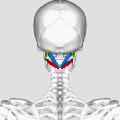| Suboccipital triangle | |
|---|---|
 Artist depiction of the muscles that border the suboccipital triangle. | |
 Muscles that border the suboccipital triangle. | |
| TA2 | 2253 |
| Anatomical terminology | |
The suboccipital triangle is a region of the neck bounded by the following three muscles of the suboccipital group of muscles:
Contents
- Rectus capitis posterior major - above and medially
- Obliquus capitis superior - above and laterally
- Obliquus capitis inferior - below and laterally
(Rectus capitis posterior minor is also in this region but does not form part of the triangle)
It is covered by a layer of dense fibro-fatty tissue, situated beneath the semispinalis capitis.
The floor is formed by the posterior atlantooccipital membrane, and the posterior arch of the atlas.
In the deep groove on the upper surface of the posterior arch of the atlas are the vertebral artery and the first cervical or suboccipital nerve.
In the past, the vertebral artery was accessed here in order to conduct angiography of the circle of Willis. Presently, formal angiography of the circle of Willis is performed via catheter angiography, with access usually being acquired at the common femoral artery. Alternatively, a computed tomographic angiogram or magnetic resonance angiogram is performed.



